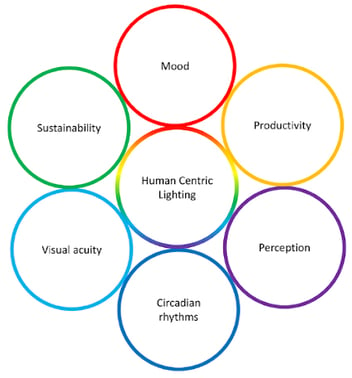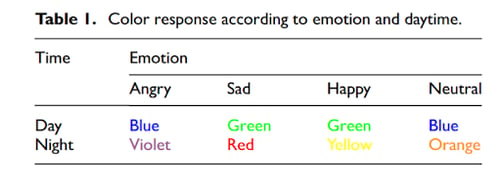
The design of lighting for the hospital setting involves balancing multiple factors, such as anticipating complex procedural scenarios and considering occupants’ biological and physiological needs. Both the needs of the patients and providers should be analyzed, as each group has different lighting-related demands. For example, medical providers require sufficient lighting to complete vital tasks, while patients may need lighting for general comfort and relaxation during their stay. Adjustable lighting can help with the needs of both. When patients' and providers' unique needs are considered, a more human-centric approach can be achieved.
The human-centric approach to designing hospital and medical lighting puts people and their needs at the center of the design and development process.
 Figure 1 Factors Contributing to Human-Centric Lighting Design
Figure 1 Factors Contributing to Human-Centric Lighting Design
Mood, productivity, perception, circadian rhythm, visual acuity, and sustainability should all be considered when designing and implementing adjustable lighting in a medical setting. This report will break down current observations and their ability to facilitate better lighting design in the following:
- Productivity
- Mood
- Perception
- Circadian rhythm
Productivity
Lighting contributes to productivity in a medical setting for both the patient and the provider. Consider patient's productivity goals: to feel better, heal, and eventually leaving the medical facility. Stress reduction is key for better and more productive patient outcomes and well-being. Patients who report high levels of hospital-related stress also report higher levels of perceived pain, lower physical status, and fewer improvements after leaving the hospital, preventing them from efficiently meeting their productivity goals (Ford et. al., 2023).
Adjustable lighting, if designed correctly, can contribute to a reduction in stress and increased productivity for a patient. It is normal for patients to experience stress resulting from medical procedures, the unfamiliar environment of the hospital, and even situations occurring outside the hospital. There are many uncontrollable factors in a medical environment, so increased patient stress levels are to be expected. Simply helping patients regain a sense of control by allowing them to adjust lighting or other physical environmental factors can help reduce stress (Andrade & Devlin, 2015).
Another detriment to a patient's productivity is the threat of hospital-induced delirium, which causes disruptions in awareness, attention and cognition. Exposure to too much artificial light, which impacts sleep, can increase the chances of delirium among patients. Exposure to daylight and patient control of artificial lighting may decrease the risk of patient disorientation, confusion or outbursts. Reducing the patient’s chances of becoming delirious improves the possibility of having a positive outcome (Bayramzadeh et. al., 2021). Lighting design has come far; new solutions allowing patients exposure to time adjustable artificial lighting mimicking natural light cycles can improve patient outcomes.
Productivity of hospital staff and providers is another human-centric factor that needs to be considered when designing medical lighting, contributing to improved patient outcomes. For those in a surgical setting, providers often prefer handheld lights attached to retractors that don't rely on head or neck angle, as the angle adjustability of these lighting solutions can provide better illumination of surgical sites. Improved visualization and ease of lighting adjustability also reduces staff exposure to occupational hazards and conditions (Curlin & Herman, 2020). Obviously, workplace injuries caused by poor visibility directly impact a provider’s productivity, and eye strain caused by too much lighting is a hazard for these providers.
Providers need a variety of lighting to perform an assortment of critical tasks: to assess a patient’s condition, administer treatments such as IVs, change wound dressings, and update charts. All of these tasks need proper lighting to ensure the provider is completing them at the highest level. Research shows that insufficient lighting leads to higher rates of errors in healthcare settings (Joseph, 2016). But, as discussed earlier, providers’ lighting needs may oppose the lighting desire of patients. Providers may require a brighter or constantly-on light for an examination or a procedure, while the patient may prefer dim or no lighting at all. Part of the human-centric design methodology involves closing the gap between lighting needs for the provider and patient desires, as both impact productivity in a medical setting.
Mood
Lighting can also impact the mood of those exposed to it. Choosing the correct light type and color can benefit hospitals and healthcare facilities by creating a positive and comfortable setting for patients and visitors. The ability to adjust lighting to help influence patients’ and providers’ emotions creates an environment conducive to a better patient experience and, consequently, better patient care and outcomes (DuBose et. al., 2022). The table below shows how colors can impact emotion.

The ability to adjust lighting color can have direct healthcare benefits beyond creating a comfortable environment. Different lighting colors and their impact on a patient’s physical and mental state are displayed below.
Blue Light can lower blood pressure.
Green Light can relax muscles and create a feeling of comfort and relaxation.
Red Light can increase blood pressure.
Yellow Light can stimulate the brain, resulting in increased alertness and optimism.
Orange Light can help relieve depression and self-pity.
Providing adjustable lighting and understanding the impact of lighting color can help influence the moods of patients, visitors, and providers, allowing for better outcomes (Cupkova et. al. 2019).
Perception
Lighting perception refers to the subjective experience of light, including its color, brightness, and direction. Patients, staff, and visitors are all affected by their perception of light within a hospital.
While each human perceives light differently, it is common for the majority of people to feel more comfortable in natural light rather than artificial light.
Adjusting the color temperature (aka correlated color temperature or CCT) of hospital lighting to directly correlate to the sun’s daily pattern of sunlight allows patients and staff to perceive the comfort of warm daylight while still under the influence of electric lighting (Dubose et. al. 2022).
Since perception is subjective, providing adjustable lighting to patients' rooms allows them to create an environment they perceive as comfortable. A patient's ability to adjust the color, brightness, and direction of their lighting gives them a sense of control and can lead to lower stress and a more optimistic outlook.
Circadian Rhythm
Lighting plays a significant factor in a human’s circadian rhythm, a natural process that takes place in response to a person’s environment throughout a 24-hour cycle. Circadian rhythms are primarily fueled by the presence and absence of light and regulate alertness and sleepiness based on light exposure. The ability to adjust and tune light can emulate the current 24-hour cycle of the sun, or it can adjust the human biological clock to fit the needs of an individual.
Regulating a patient’s circadian rhythm can help control the length and quality of their stay in a medical facility. For example, simulated bright light treatments in the morning suppress melatonin. Melatonin suppression directly corresponds to reducing depression, whether it be seasonal or bipolar depression. Adjusting a patient’s environment to follow the sun’s light phases improves sleep cycles, allowing mental and physical rest. Increased rest quality can help decrease the length of stay and speed up the healing process (Joseph, 2006).
Adjusting light to regulate circadian rhythms can also benefit medical staff, especially during night shift hours. This adjustability allows a staff member's internal clock to adapt and better align their internal rhythms with workday rhythms. When a worker’s internal rhythms better match their flow of duties, there is less drowsiness, making it much easier to focus on a task and less likely to make a mistake.
Conclusion
The human-centric approach to adjustable lighting design can significantly improve a patient's experience and outcome. By allowing patients to personalize lighting to fit their preferences, lighting becomes a healthcare modality that promotes better sleep, reduces anxiety and stress, and provides a more comfortable healing environment.
In addition, adjustable lighting also benefits hospital staff and providers. Giving providers adjustable lighting can help treatment to be performed more efficiently, with less eye strain, fatigue, and opportunities for mistakes. It can also help the night shift staff adjust their body's natural circadian rhythm to the rhythm of the workplace.
The human-centric approach to adjustable lighting design can be considered a holistic approach, as it encompasses the needs of both; patients and medical staff. By prioritizing factors like mood, productivity, perception, circadian rhythm, visual acuity, and sustainability, lighting can contribute to better patient outcomes and more productive medical staff. As we explore and refine this human-centric approach to hospital lighting design, we can continue to strive to create a more comfortable and effective medical environment for all.
Frequently Asked Questions
What is human-centric hospital lighting?
Human-centric lighting is a design approach that prioritizes the needs, comfort, and well-being of both patients and healthcare providers. It focuses on optimizing factors like productivity, mood, perception, and circadian rhythm through adjustable lighting solutions.
Why is adjustable lighting important in hospitals?
Adjustable lighting allows both patients and providers to control brightness, color, and direction, which can reduce stress, improve comfort, enhance visibility for medical procedures, and support better patient recovery.
How does lighting affect patient productivity and recovery?
Proper lighting reduces stress, minimizes the risk of hospital-induced delirium, and helps patients feel more in control of their environment. These factors can contribute to faster healing and better overall outcomes.
What role does perception play in hospital lighting design?
Perception refers to how individuals experience light. Since it’s subjective, providing adjustable lighting helps patients and staff create an environment they find comfortable, which can lower stress and improve satisfaction.
Ford, D. M., Budworth, L., Lawton, R., Teale, E. A., & O'Connor, D. B. (2023). In-hospital stress and patient outcomes: A systematic review and meta-analysis. PloS one, 18(3), e0282789. https://doi.org/10.1371/journal.pone.0282789
Joseph, A., PH.D. (2006). Impact of Light on Outcomes in Healthcare Settings. The Center for Health Design. https://www.healthdesign.org/chd/research/impact-light-outcomes-healthcare-settings
DuBose, J., MS, Davis, R. G., PhD, Campiglia, G., BS, Wilkerson, A., PhD, & Zimring, C., PhD (2022). Lighting the Patient Room of the Future: Evaluating Different Lighting Conditions From the Patient Perspective. HERD: Health Environments Research & Design Journal, 15(2), 79-95. https://doi.org/10.1177/19375867211063481
Cupkova D, Kajati E, Mocnej J, Papcun P, Koziorek J, Zolotova I. Intelligent human-centric lighting for mental wellbeing improvement. International Journal of Distributed Sensor Networks. 2019;15(9). doi:10.1177/1550147719875878
Andrade, C. C., & Devlin, A. S. (2015). Stress reduction in the hospital room: Applying Ulrich's theory of supportive design. Journal of Environmental Psychology, 41, 125-134. https://doi.org/10.1016/j.jenvp.2014.12.00
Bayramzadeh, S., Ahmadpour, S., & Aghaei, P. (2021). The relationship between sensory stimuli and the physical environment in complex healthcare settings: A systematic literature review. Intensive & critical care nursing, 67, 103111. https://doi.org/10.1016/j.iccn.2021.103111
Curlin, J., & Herman, C. K. (2020). Current State of Surgical Lighting. Surgery Journal (New York, N.Y.), 6(2), e87–e97. https://doi.org/10.1055/s-0040-1710529
Jessica Quartermaine
Jessica is a Portfolio Manager at Lumitex. She works across Lumitex’s product line, developing products from ideation to release. Jessica uses her experiences in helping to develop new medical devices for Lumitex’s customers.

Carolyn Guzik
Carolyn Guzik is an Optical Engineer at Lumitex. She is well experienced at designing lighting systems and integrating light into products. With her background and experience, Carolyn ensures that Lumitex develops the best quality of light to improve life. Carolyn graduated from Rose-Hulman Institute of Technology with a Bachelor of Science in Optical Engineering.





Comments